

Vol. 28 No. 8 May 1999 http://physics.weber.edu/oas/oas.html
THE MAY MEETING
The May 1999 meeting of the Ogden Astronomical Society will come to order at 7:30 p.m. in the Ott Planetarium on the Weber State University campus this Thursday May 13.
On Sunday evening, last April 18, an occultation of the star Aldebaran was observed and photographed by several OAS members. Certain locations in northern Weber County were right along the southern graze line for this event. Jim Seargeant and Dave Miller have some interesting video of the occultation which they will share with the members at this month's meeting; (also see the articles in this issue).
Any other members who observed the Aldebaran occultation are invited to reflect on what they saw during this event at Thursday's meeting.
Another interesting occultation will be observable from our latitude on Friday evening
May 21 when the moon skirts by Regulus. Observing plans will be considered at the meeting.
ANTELOPE ISLAND IN MAY
Saturday May 22, 1999 is the next public star party scheduled at Antelope Island State Park. We have a guest speaker who will conduct the "Tour of the Universe" slide show this month. Mr. Von Del Chamberlain, former Director of the Hansen Planetarium, has accepted the invitation to speak to the crowd before the star party.
Members should be in place and set up by 7:30 p.m. in order to avoid maneuvering
vehicles around the visitors. Weather permitting, this should be great fun. Last month was
very successful with about twenty telescopes available to look through. Join the fun.
THE PRESIDENT'S PARSEC
Greetings Earthlings: The first star party of the year at the
island went fairly well considering it was April. The temp was quite nice and you had to
pick your spots in the sky as clouds permitted. The crowd was a really good bunch and
small in number allowing lots of time for casual discussions of Astro- related subjects. 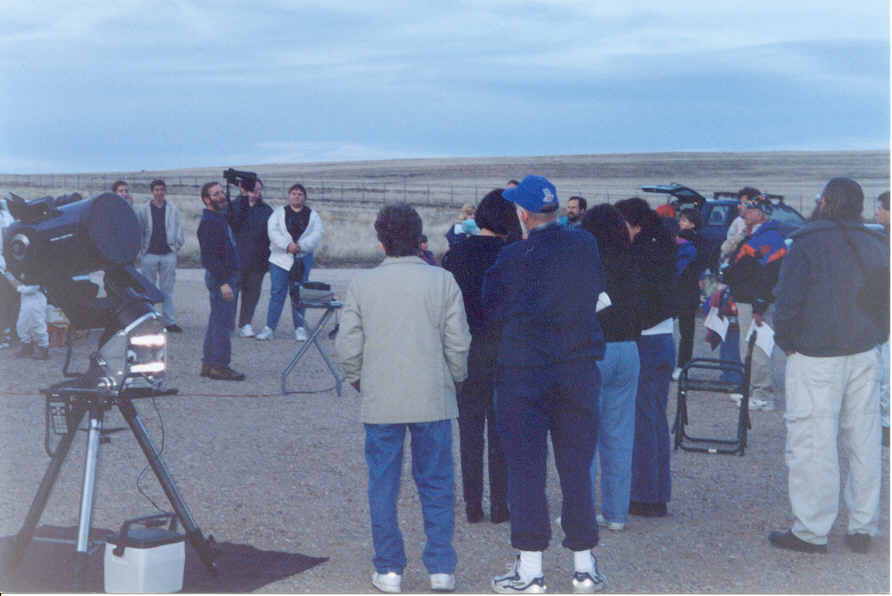
Mars is available for optimum viewing the next few weeks. One thing I would recommend you use is a #23 orange filter. You can order one from Orion and have it in a couple of days. The filter really brings out the polar caps and surface markings plus it reduces the glare from the planet. And because it is Mars the orange effect really adds some realism at star parties ( no that's not cheating).
The best combination I found to work on my 16 in. is to use an orange filter with a Meade 24.5 super wide in a 2.5x
Barlow and to mask down the front of the tube to a 5 in. opening. Works every time.
Here is a teaser I came across on Astro- Mart last night. Someone is selling a 40 in., two inch thick, fine annealed Pyrex blank for only $2000. That's a huge savings over retail (around $5000). I immediately made some measurements on my grinding machine and miraculously its capacity expanded to accommodate this monster. I doubt my finances will expand as rapidly . But maybe the "someday to be named " observatory at WSU might want to get a dandy head start on the project and buy this brute. Maybe I'll talk this guy into dragging the thing to Riverside and then offer him half price so he won't have to drag it back to New Mexico.
Here is something I found in this months Amateur Astronomy:
Top Ten ways to know you are a Deep Sky addict
10) You consider Jupiter "light pollution"
9) You pack dry ice around your head to reduce the "noise" from your retina and optic nerve.
8) You believe M13 ruined your dark adaptation.
7) You observe M42 at the end of an observing session because it DOES ruin your dark adaptation!
6) You've been thinking that the black hoods the 14th century monks wore was a pretty cool idea.
5) Your not sure anything in this solar system counts as Astronomy any more.
4) You actually use "Uranometria" and can quote page numbers for objects.
3) a. You can talk with a red flashlight in your mouth
b. You can understand someone talking with a red flashlight in THEIR mouth.
2) You think that if only the stars would go away it might get really dark and,
the number one way you know you're a Deep Sky addict
1) You have blackened the edges of your eyeglasses
The Prez
Great Video of a Non-event
by Dave Miller
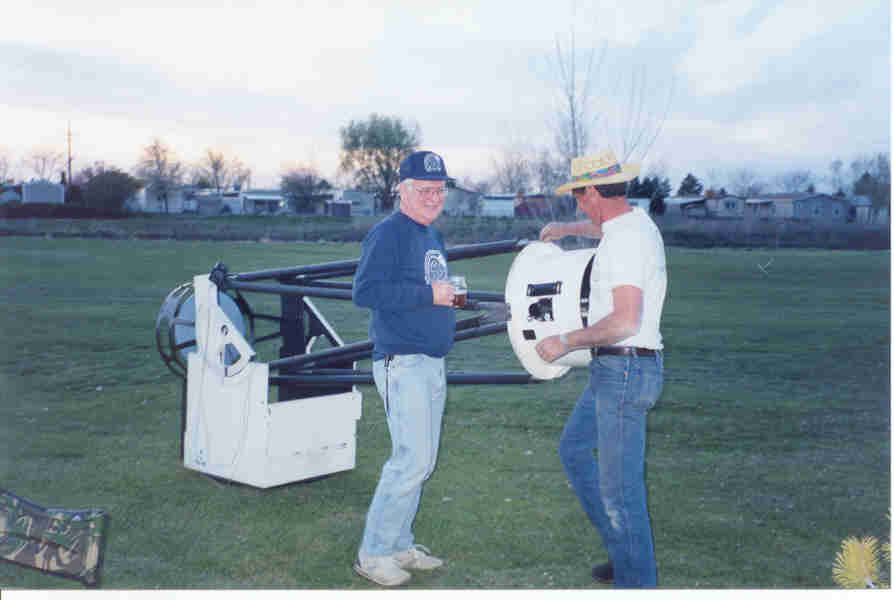
Bob Tillotson and I set up on the west side of Doug Say's yard in Farr West for the Moon/Aldebaran graze on the evening of 18 April and got some decent video, but were too far southwest to see Aldebaran wink out behind the mountains on the limb of the moon. Close, but no cigar. Late that afternoon, we mounted my Canon A1 Mark II High Band 8mm camcorder with the Canon 3X tele-extender lens attached onto Bob's Celestron C-8 to take advantage of its clock drive, which was set in the lunar tracking mode. Doug was kind enough to run an extension cord from his house so I could run the camcorder off its AC converter. Bob ran his scope drive on a lead-acid battery. After zooming the camcorder's main lens out to max telephoto, manually focusing and setting the aperture, we were ready to calibrate time and measure the coordinates of our observation site.
If you've looked up the International Occultation Timing Association (IOTA) web site on the Internet (http://lunar-occultations.com/iota/iotandx.htm), you know that they solicit video tapes of occultations and grazes from anyone, no matter how amateurish they may be. They do ask that you include some accurate method of calibrating the time, either on the audio or the video track, or both. Also, they want accurate coordinates for your observing site, and a single reading from a standard commercial GPS receiver won't do; it has to be expensive differential GPS equipment.
The alternatives are (1) to average a number of readings from your Mickey Mouse GPS receiver taken over a period of at least an hour and a half or (2) measure how far you are from one or two landmarks (such as street intersections) on an accurate map. To calibrate the time on the audio track, I brought along a small Radio Shack short-wave radio and tuned it to WWV. The time hacks are clearly audible on the finished tape, which would have been a life saver (if we had actually been able to see Aldebaran wink out), because I had a problem with the visual calibration method I chose. For the latter, I took a minute or so of video of my radio controlled clock a little before the event in order to calibrate the time shown on the video screen. The radio controlled quartz clock is automatically reset six time a day from the NIST atomic clock. I did this a little before sunset, while there was still enough light to see the clock. However, when the time came to tape the graze, I noticed that the time shown in the viewfinder seemed to have lost several minutes from the actual time. Not having enough time to think the problem through and repeat the calibration, I just turned off the time stamp in the camera and relied upon the audio alone. Incidentally, the time appearing on my GPS receiver was perceptibly (maybe a tenth of a second or so) slower than that shown on the radio controlled clock. Hmmmm....
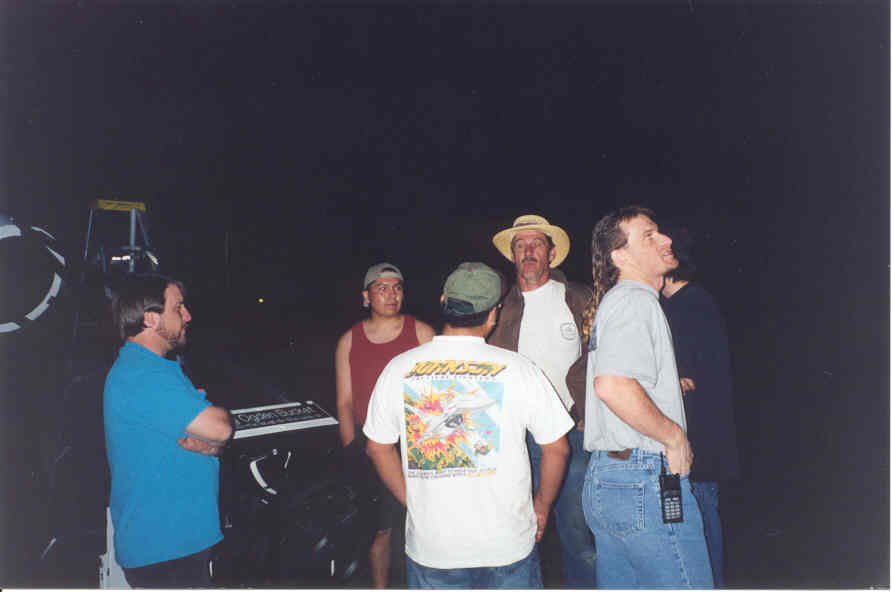
There is a "T" in the road next to Doug's yard, and we carefully set up the telescope/camcorder equipment directly north of the "T". Bob and I then measured the distance from the center of the intersection to a point under the scope and recorded it. In the meantime, I had set my GPS receiver under the scope and recorded a number of sets of coordinates, which I later averaged. (Your coordinates are N 41 deg 16.583 min, W 112 deg 01.791 min, Doug). I marked the position of the observation site, giving the averaged coordinates and the distance to the intersection, on a detailed map of Doug's neighborhood that I printed from Delorme's Street Atlas USA software. As Aldebaran slowly caught up to the Moon, we started the camcorder up and began observing visually, Bob through the eyepiece on his Celestron, Doug on the club's B.O.B., while I used my 25 X 100 binoculars. I mean to tell you, it was really close, but none of us even saw Aldebaran dim a little. After all the preparation, it was kind of disappointing (for me, at least) not to get to see Aldebaran wink out a time or two. Bob and Doug seemed a little more philosophical about it.
Well, all this turned out to be just good practice for the 21 May lunar occultation of Regulus. If we get as good video of that event, I'll send a total package including both events to IOTA.
davimill2@cwix.com
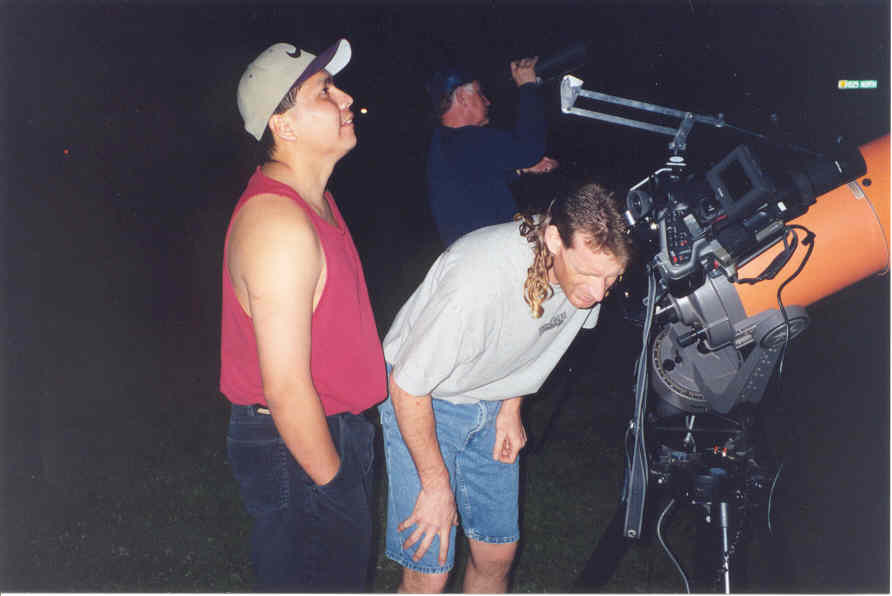
Photographs in this article are by Bob Tillotson
ALDEBARAN GRAZE
by Jim Seargeant
I've always be interested in activities that permit the amateur astronomer to make observations that contribute to the science of astronomy. There are many ways to do this using many kinds of equipment. Comet Hale-Bopp was discovered using the Mark I human eyeball augmented by fairly simple telescopes. The latest issue of Sky and Telescope had a wonderful article about Braeside Observatory, which Robert Fried built and uses to make photometric observations using a sophisticated CCD camera.
Another type of observation that amateurs can make is to record occultations. Occultations occur when a relatively nearby object passes in front of a star and darkens (occults) it. The nearby object may be an asteroid, another planet, or, very often, our moon. Useful information can be derived from a recording of an occultation if accurate timing and observing position data are available. Organizations such as the International Occultation Timing Association (IOTA) promote these observations and perform data collection and reduction services. Their web page is at www.lunar-occultations.com and occultation predictions and charts of appropriate observing locations are available there.
Some weeks ago Pat Wiggins of the Salt Lake club circulated a notice that on Sunday, 18 April, at about 9:40 PM local time, the moon would occult Aldebaran and that we would be near the position from which a graze could be observed. A Lunar graze can be interesting because the rough edge of the moon can cause the occulted star to flicker in and out of visibility. A map downloaded from the IOTA website showed that one of the best bands of high graze probability passed just north of Doug Say's house. Several of us assembled there on the appointed night. Some stayed to enjoy Doug's hospitality, golf, and refreshments, but I decided to get as close to the optimum position as I could. I found Pat Wiggins in Plain City and set up there.
To cut to the chase, both Pat and I were able to record the graze, and it really was
interesting. We were in luck with the weather, the equipment worked fairly well, and we
were in the right position. I'll have the video tape to show at our May OAS club meeting
and will also describe the equipment setup then.
Jim Seargeant's Images
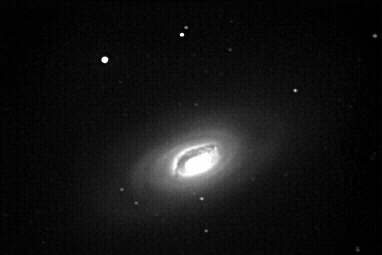
M64 - The Black-eye Galaxy
This image of M64 - the Black-eye galaxy - was taken by three of WSU Professor Adam Johnston's students, Justin Urry, Lindsay Rusch, and Carol Westaway on 15 Apr 1999. This is actually the result of combining three, four minute exposures. The first shot was taken at about 11:00 PM and we would have kept shooting - it was a fine, clear night - but Carol had to rush her tax return to the post office before the deadline. I hope she made it. The 9th-magnitude M64 is one of the many galaxies in the area of Coma Berenices. A dark streak of dust causes the "black eye".
We've had a shot of M64 taken with my system in the newsletter before, but combining the three good shots has yielded the best image of it yet. Placing a relatively bright star under the guide chip is key to using the AO-7 adaptive optics (or active optics as some prefer) to give long, sharp images. Normally, the camera is mounted with its back facing up on the telescope, which places the guide chip north of the desired object. This time, I mounted the camera with its back facing down on the telescope, which placed the guide chip south of M64 and right over a lovely 11th magnitude star. The ST-7 will guide nicely at a tracking exposure of .11 sec - the shortest possible - on such a star and yield beautifully sharp images.
One of the consequences of turning the camera over like that is the change in image orientation. Every time I do that I have to relearn the image directions vs. the LX-200's control pad joystick directions. It's all right after a few false moves, but with students watching it's a bit embarrassing to be sending the telescope off in the wrong direction.
Why three, four minute exposures instead of a single, 12 minute shot? If a star is overexposed by a CCD camera (at least one like mine) the electrons falling into the overexposed pixels will spill over into neighboring pixels in the direction of the readout. This gives an unsightly spike projecting from one side of the star's image and is called "blooming". The star in the upper right of this M64 image had an intensity of 65535 counts - the maximum possible. The center of that star is actually overexposed, but any blooming is confined to the boundary of the star and doesn't ruin the image. Any more exposure and the blooming would have spilled out of the star.
More exposure is desirable, though, to improve the signal to noise ratio of the image and bring out the detail in the dimmer areas of the galaxy. The answer is to take two or more shots, each of the maximum possible exposure but just short of blooming, and then combine the images in the computer. When images are combined like this, the center of the bright stars quickly reach the maximum possible exposure, but in the computer they do not spill over into the neighboring pixels and there is no blooming. No detail is lost as a result of overexposing the star because there is no detail there anyway - it's effectively a point source of light. Meanwhile the faint areas of the galaxy add up to a reasonable exposure level and fainter detail - for instance in the dust lane.
I'll have the individual shots and the final, combined image at our May meeting.
MINUTES
OGDEN ASTRONOMICAL SOCIETY
April 8, 1999
The regular meeting of the Ogden Astronomical Society was called to order by club president Ron Vanderhule at 7:30 p.m.
Ron and participants in the mirror grinding project discussed the progress to date and set a time for the next grinding session.
The club's former president, Steve Peterson, has recently remarried and moved to a rural town only a few miles outside of Grand Junction, Colorado. Steve reports the skies are great and piece reigns. He has extended an invitation to OAS members to join him in an observing session on a date to be announced.
John Sohl described the recent perplexity surrounding the selection of the WSU observatory site. When difficulties arose with the original location several other sites were considered. They all proved more challenging than the original so the first site is now being reconsidered. Money is, of course, always tight. If any generous philanthropist can donate $15,000.00 to help complete the project, his name may be adopted to the site.
The first public star party at Antelope Island State Park is scheduled for April 17th. Dr. Sohl plans to conduct the slide presentation. Weather permitting, members should show up early enough so as not to have to plow their vehicles through innocent visitors.
The first of several videos planned for the meeting was run. Project Stardust, the NASA mission which will return cometary dust for study was run first. Secondly, a clever and humorous video produced by members of SLAS on how (not) to make a astronomical mirror was presented. Finally, a popular short film Powers of Ten was offered by Wayne Sumner.
Wayne then took the floor to discuss how astronomical distances are determined.
The meeting adjourned to informal discussions at 9:10 p.m.
Bob Tillotson, Secretary
TELESCOPES FOR SALE
17.5" Coulter Optical Dobsonian. Over 200 lbs. No extras. $890 Pick up just north of Logan. Tom Miller 435-563-9593 tmiller@onlinex.net
8-inch Dobsonian telescope (3 yr old), with Telrad, three eyepieces, carrying cases, $300.00 OBO, call
(435) 863-2905 day, or (435)-723-5198 evening.
1. Celestron Firstscope 80mmEQ Model #21070 with Tripod; no eyepiece or star diagonal: $89, OBO.
2. 10 inch Dobsonian, homemade, of Richard Berry's design with pneumatic wheels for easy movement. Galaxy mirror figured by J.C. Wilkinson, FL 58.9"; a 2.6 inch diagonal, Novak mirror cell and spider; Orion two-inch high-profile R&P focuser with 2-1 1/4" reducer: Telrad
finder. Great telescope especially for planets and the moon as well as deep sky objects. Or design a new truss system using the mirror, cell, and spider. $395 OBO.
Bob Neill (801) 479-6977, theneills@eartlink.net
The following is a letter to the Editor of Natural History magazine which Dave
Miller was kind enough to share with The Star Diagonal:
To The Editor:
I always enjoy reading the columns by Natural History's writers, Stephen J. Gould, Neil de Grasse Tyson, and Joe Rao. I have learned much from them over the years, although I wish I could have retained more.
In the March issue, Mr. Rao writes about the concept of the "blue moon", said to be the second full moon when there are two in any given calendar month. I had always believed this to be the definition, but was surprised to read another, apparently more historically accurate, explanation in the May 1999 issue of Sky & Telescope magazine. The article, "What's a Blue Moon", on page 37, claims that an error in their March 1946 issue is to blame for the misconception, which has been perpetuated to the point that it has now become the de facto definition. (This reminds me of the commonly accepted assumption that the twentieth century/second millennium ends at midnight 31 December 1999, when it really ends a year later). The explanation given by Sky & Telescope is that a blue moon is the third full moon in a quarter that has four full moons, rather than the usual three.
Definitions of the beginning and end of the seasons (quarters) are not dependent upon when the longitude of the sun actually passes through 0, 90, 180, and 270 degrees right ascension (celestial longitude), but are based on the fictitious dynamical mean sun, which moves along the ecliptic at a constant rate, unlike the true sun. This produces seasons of exactly the same length, which don't necessarily begin and end when the astronomical seasons do. The reason that the third full moon, not the fourth, is called the blue moon is somewhat more esoteric; mainly having to do with rules established by the Roman Catholic Church in the sixteenth century to mark seasons and religious holidays when the Julian calendar was replaced by the Gregorian calendar. A blue moon apparently can't fall on a "moon" of another name that has religious significance, like the Lenten moon, which is defined as the last moon of winter and falls within Lent.
These definitions have traditionally been used by many almanacs, such as the Maine Farmers' Almanac, to determine which are the blue moons, and even they don't always get it right by the rules they are trying to follow. Naming full moons probably was very helpful before the common people had wall calendars, almanacs and clocks, but now it is only of historical interest. It made it much easier to know when to plant, when to harvest, and when to celebrate Easter.
It is all pretty confusing, and it is no wonder that we have so
readily accepted the much simpler explanation. I don't know whether to thank Sky &
Telescope (for simplifying things and removing the religious connotation) or blame
Dennis the Small (the monk who was in charge of the calendar reform).
David Miller
Riverdale, Utah
davimill2@cwix.com
The following information was received from Dr. Sohl on the eave of this month's printing:
Observatory Update.
The on-campus observatory project is on track again. We have the final go ahead and have started issuing purchase orders for the building and the slab. The location will be north of the planetarium in the upper of the two dirt parking lots.
Initially, it will consist of a building with power and an "L" shaped concrete pad wrapped around the building on the east and south sides. There will be room for at least 5 scopes including two permanently mounted piers. There will also be provision for computer control and CCD imaging. The building will have red and white lights on dimmers to illuminate the scope pad area. The street light that is almost directly above the observatory will have a switch to turn it off.
Initially the two scopes assigned to the piers will be the C-8 and the Meade 16. The CCD and computer control will be connected to the Meade with the provision for connecting the C-8 prewired in, just in case.
With luck we will be using it by the time Autumn semester starts.
Thanks, John
Your
OGDEN ASTRONOMICAL SOCIETY
EXECUTIVE COMMITTEE
Ron Vanderhule President 544-9458 nitesite@lgcy.com
Dave Dunn V-Pres. 544-7705
Bob Tillotson Secretary 773-8106 bob@skyplanner.com
Doug Say Treasurer 731-7324 dougsay@konnections.com
This page was last revised on May 11, 1999 and has had visitors.